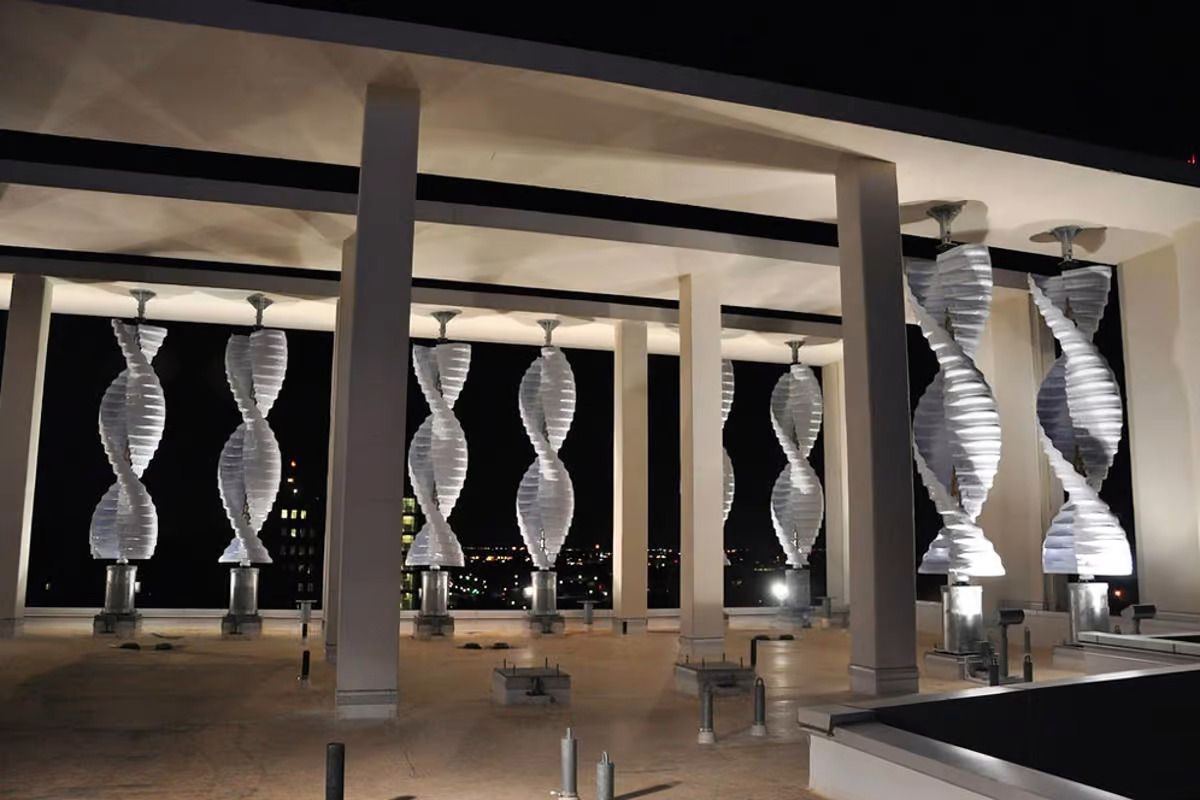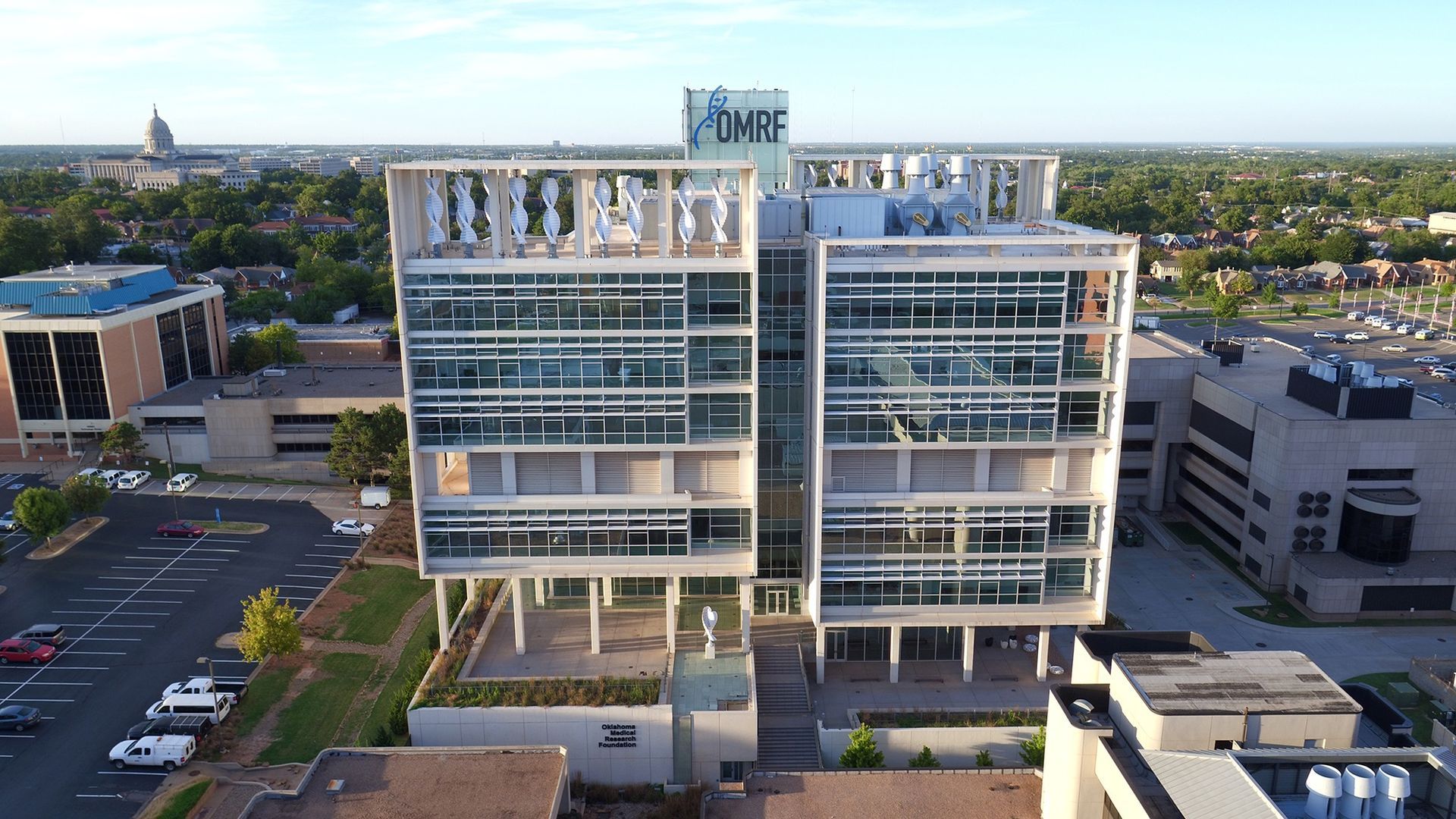World’s Largest Rooftop Wind Farm: world record in Oklahoma City, Oklahoma

Oklahoma City, Oklahoma, United States--Venger Wind and US renewable distributor SWG Energy installed a rooftop wind farm atop the Oklahoma Medical Research Foundation (OMRF) in Oklahoma City, Oklahoma, United States; the installation of the 18 wind turbines makes the entire project the World’s Largest Rooftop Wind Farm, according to the WORLD RECORD ACADEMY.

"Venger Wind and US renewable distributor SWG Energy just installed the world’s largest rooftop wind farm atop the Oklahoma Medical Research Foundation (OMRF) in Oklahoma City. The project saw Venger Wind construct 18 V2 vertical axis wind turbines on the medical center’s roof as part of OMRF’s sustainability strategy to create a zero emissions research tower," the Innovation Toronto says.
"The omni-directional wind turbines have been integrated into the design of the building and precisely positioned to collect wind from both the North and South sides of the rooftop farm. The installation of the 18 wind turbines makes the entire project the largest building integrated wind energy system in the U.S.
"Unlike most vertical wind turbines, which are relatively modest in size, the V2 wind turbines are massive. They stand 18.5 feet tall and are rated at 4.5 kilowatts each. Unlike conventional wind turbines that use energy from the grid to start, the vertical turbines start producing electricity at 8.9 mph, which is well below Oklahoma City’s annual wind speed average."
"Speaking about the project, Ken Morgan, Venger Wind’s Chairman and CMO said; “This project took a lot of hard work and long hours from all involved. This is a groundbreaking success for Venger Wind and the small wind industry worldwide," the InHabitat says.
"The potential to provide wind energy at the point of use, within urban environments is a major paradigm shift from the typical large wind scenarios where multi megawatt systems are forced to be installed farther and farther away from populations where the energy is needed most.”
“The small wind industry still has a long way to go in educating ourselves and our customers on properly assessing and installing wind turbines on buildings. It truly is a whole new science that has emerged and we are very excited with the Architects and Engineers we currently work with whom are pioneering new concepts for wind turbine integration into buildings. The OMRF building is an exemplary example of what is possible.”
"The roof of the OMRF is now graced with 18 of Venger's 18.5-ft (5.6-m) V2 vertical-axis wind turbines. Each has a capacity of 4.5 kW, giving the installation a theoretical capacity of 81 kW overall. As rooftop installations go, that's certainly nothing to be sniffed at. As a basis for comparison, the three turbines integrated into London's Strata residential block have a combined capacity of 57 kW," the New Atlas says.
"The cut-in speed of the turbines is 8.9 mph (or 4 m/s). That's the wind speed required for the turbines to even begin generating power, and is quite high compared to other wind turbines designed for urban conditions. The McCamley turbine we looked at recently begins to be productive in winds as weak as 4 mph (1.8 m/s). In Venger's favor is that they are sited on the 130-foot (40-m) tall OMRF, where wind speeds are certain to be higher.
"An OMRF press release says that the turbines are projected to produce 85,500 kWh of energy per year, equivalent to seven average-sized American homes (and the amount of energy generated were the turbines to run under ideal conditions for 1000 hours.) Refreshingly, the release also points out this will not be enough energy to meet the OMRF's needs, but doesn't let us know what proportion of its demand that would cover."
"Venger Wind is a large vertical axis wind turbine manufacturer based in Henderson,Nevada, that produces wind power solutions for many large companies and other clients around the world. The vertical axis wind turbines the company produces are usually installed on rooftops, cell towers and monopoles. The company has a variety of products to help meet their client’s needs," the
Vertical Wind says.
"Venger Wind vertical wind turbines have a unique look. The styling of the large, white wind turbines are more reminiscent of an art installation, then an energy producing mechanical device. A Venger VAWT in motion is definitely a sight to behold!
"The company has been involved in a variety of projects, but their largest so far has been the installation of 18 V2 vertical axis wind turbines atop the Oklahoma Medical Research Foundation building resulting in what is currently the largest rooftop wind farm in the US. The OMRF project is designed to cut carbon emissions by approximately 2 million pounds annually."
"A wind turbine is a device that converts the kinetic energy of wind into electrical energy. As of 2020, hundreds of thousands of large turbines, in installations known as wind farms, were generating over 650 gigawatts of power, with 60 GW added each year.
"Wind turbines are an increasingly important source of intermittent renewable energy, and are used in many countries to lower energy costs and reduce reliance on fossil fuels. One study claimed that, as of 2009, wind had the "lowest relative greenhouse gas emissions, the least water consumption demands and the most favorable social impacts" compared to photovoltaic, hydro, geothermal, coal and gas energy sources.
"Smaller wind turbines are used for applications such as battery charging and remote devices such as traffic warning signs. Larger turbines can contribute to a domestic power supply while selling unused power back to the utility supplier via the electrical grid. Wind turbines are manufactured in a wide range of sizes, with either horizontal or vertical axes, though horizontal is most common." (Wikipedia)
"At more than 18 feet tall, the helical-shaped wind turbines will provide more than 85,500 kilowatt hours of electricity per year to the energy-hungry research facility," The Oklahoman says.
"Part of the funding for the $1 million wind turbine project came from McAlester's The Puterbaugh Foundation. J.G. Puterbaugh, a coal magnate in Eastern Oklahoma for much of the 20th century, was the first president of OMRF.
"Dallas-based SWG Energy Inc. led the installation of the 4.5 kilowatt turbines. Joe Willix, SWG Energy president, said the community-scale wind project is perfectly suited for urban areas."


